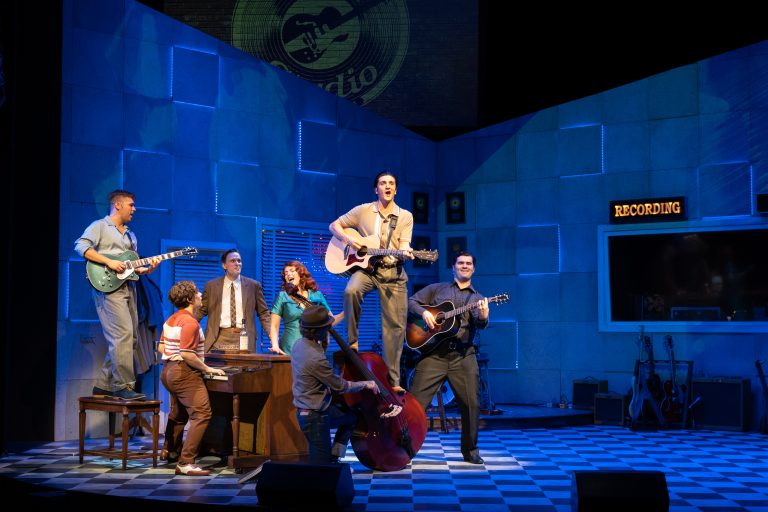

Cast of Million Dollar Quartet, 2023; set design by Patrick Rizzotti; costume design by Alaia Hamer; lighting design by Itai Erdal; photo by Moonrider Productions for the Arts Club Theatre Company
In addition to their teaching and research work, many of our faculty also maintain active creative practices. Associate Professor Patrick Rizzotti is an accomplished set designer, living and working between Vancouver and New York City. He recently designed the set for the Arts Club Theatre Company’s Million Dollar Quartet—now playing at the Granville Island Stage. We chatted with Patrick about his design process and his process of working on the show.
Can you give us some insight into the overall concept and vision behind your design for Million Dollar Quartet?


The set itself is an abstraction of the actual studio where the iconic 1956 recording session took place, featuring Elvis Presley, Johnny Cash, Carl Perkins, and Jerry Lee Lewis. It incorporates acoustic tiles that extend beyond the expected edges of the world, drawing the audience’s focus into the space. The inclusion of naturalistic elements such as the tiles, floor, doors, windows, and the neon Sun Studio sign grounds it in reality. However, the design also intentionally plays with scale and details. The walls are oversized, creating a sense of grandeur and significance. On the other hand, certain details like light switches and electrical outlets are omitted, adding a touch of abstraction. This approach allows the audience to have a foundation of the space while also leaving room for their imagination to fill in the gaps. It encourages them to recall their own personal experiences and memories associated with the songs being performed.
Beyond the studio, the world is depicted as a void, surrounded in black. This deliberate choice aims to focus the audience’s attention solely on the individuals present in the room and the historic moment they are creating. The recording booth and the world outside the front door are intentionally omitted, emphasizing the intimate space and the significance of the artists and their music.
To enhance the smaller moments and highlight the musicians’ skills, we utilize live video feeds that project their fingers playing the piano or strumming an oversized guitar on the studio walls.
Overall, the design concept for Million Dollar Quartet seeks to evoke a sense of nostalgia and emotion, while also highlighting the collision between the past and the present, and the power of music to transcend time.
Did you encounter any challenges during the design process?
Yes, the light wall that comes in at the end of the show posed a challenge. I needed to create something that contrasted the imagery the audience has been looking at for the past 80 minutes, but the space at the Granville Island Stage made it tricky to simply fly something in front of the existing set. So, we had to get creative to come up with a visually interesting idea that supported the shift away from the studio to a rock and roll concert, did not obscure the two band members that would remain upstage of it, and could be technically executed within the space and resources available. I think the director, lighting designer, scenic shop staff, and I tried about 10 iterations!
How did you collaborate with the other designers to create a cohesive look for the production?
Given the inclusion of live video in the production, the director, projection designer, lighting designer, and I worked closely with the scenic and paint shop staff. As a group, we spent time testing textures and colors to find the appropriate materials and palette for the studio walls and projection surfaces. The staff in the scenic shop played a crucial role in helping the lighting designer and me explore and test options for the light wall that appears at the end of the show.


Cast of Million Dollar Quartet, 2023; set design by Patrick Rizzotti; costume design by Alaia Hamer; lighting design by Itai Erdal; photo by Moonrider Productions for the Arts Club Theatre Company
What did you enjoy most about working on this project?
The collaboration from everyone involved. The Arts Club is an amazing place to work. Everyone on staff was invited to the first rehearsal for the design presentations and introductions. It’s a great way to see just how many people are working to bring each show to life. I also loved my coffee chats with Bobby during the process. We’d meet at a new coffee shop each time and talk through ideas, look at images, discuss how a moment might look or work. He had a clear vision for why he wanted to tell this story. He was also incredibly open to ideas and that allowed the creative team to come together as a unit to support the show.
Any other exciting summer plans?
I was in Prague earlier this summer as the Associate Artistic Director for the US National and Emerging Exhibits at the Prague Quadrennial. I’m also starting work on Cinderella at Gateway Theatre (onstage over the winter holidays). Then, I’m off to NYC next week to see some shows and meet with a few director and designer friends regarding potential upcoming projects.
Million Dollar Quartet also features work by alumni Nick Fontaine (Performer), Bobby Garcia (Director), Alaia Hamer (Costumer Designer), and Pamela Jakobs (Stage Manager). The production runs at The Granville Island Stage until August 6.


